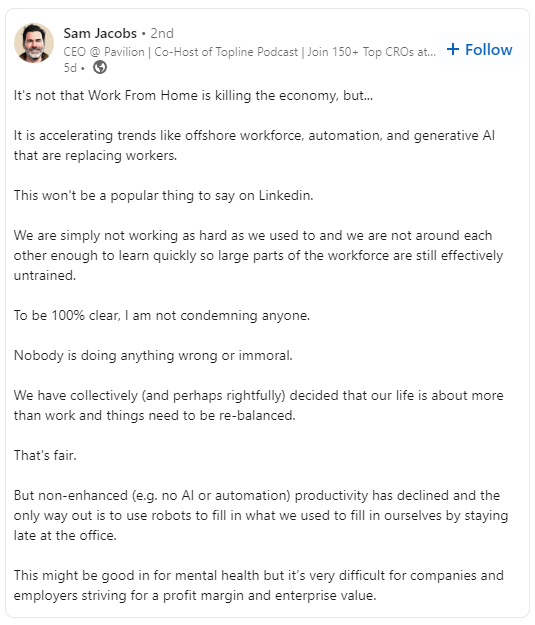Working from home is not the problem
Let's start talking through how we manage distributed teams effectively
I intended to use this week’s newsletter to start writing about making hiring decisions when building teams, but I was stopped in my tracks by a LinkedIn post that connected Working from Home to an acceleration in outsourcing, automation, and artificial intelligence (see below). The connection is a poor one and there is little evidence to justify the “take.” Opinions, of course, are allowed but when presented as some deep insight I feel compelled to offer my own view on the topic.
Working from home
The Covid-19 pandemic forced all of us into a remote world and many of us in technology departments were thrust into long hours as we tried to get entire businesses back to some level of productivity. Remote working was not a new thing in 2020. The internet had enabled remote work and supported distributed teams for decades. Yes, this was an extreme version of remote work, but I wasn’t writing with a typewriter in 2009 when I was traveling around the country using my trusty Blackberry as a hotspot.
And in 2012, when PwC started to push a “global delivery model” we started to really understand a 24/7 workforce. Work was packaged up and sent to India or China at night and then reviewed in the morning. These distributed teams were designed to lower rates while maintaining margins. I guess “riffing” in the office only matters for jobs that can’t be offshored.
Fast-forward to 2018 when I joined Citizens and where I found an organization that culturally worked from home on Fridays. It seemed that most of the workforce was in the office 3-4 days a week and home 1-2 days. No mandates, no spyware. It was just how it worked and no one paid any attention to it. Citizens heavily leveraged offshore providers during this time as well - not because people worked from home on Fridays, but because we needed a lot of resources for different projects and the cost model worked.
So maybe my experience was unique but, again, I don’t see any correlation between working from home and acceleration in some of these trends. Saying we aren’t working as hard as we used to is also a slap in the face. My hours are higher when I work from home, not lower, and I suspect most people find themselves in a similar spot.
I think the broader issue with “work from home” is that it is far more complex than being in an office or not. Millennials, for example, are in their “young family” years. The school bus coming at 8:45 AM for pick-up and dropping kids back off at 3:30 PM creates a much different work situation for someone on that schedule than it does with someone with kids in college (or older).
In 1970 the rate of families that had both parents working full-time was 31% compared to 46% in 2015 (Source; I couldn't find more recent data). More two-working-parent families means a higher need for flexibility. Long commutes and 5 days of in-person work are not aligned to that family setting.
There is also the generational trend of Millennial fathers wanting to be more involved with parenting duties when compared to prior generations. That doesn’t mean they aren’t focused on careers, it means that sometimes they need to be the one to take a couple of hours out of the day to get someone to the Doctor’s office.
I don’t think we can brand workers as lazy and then use that to justify investments in AI/Outsourcing/Automation. There is far too much complexity to make that simple connection. What might be more interesting is if organizations used this opportunity to experiment with how and where work happens. The “sit in a cube” model hasn’t been challenged enough; there is a window for disruption there.
If it’s not the lazy people, what is it?
But since our original poster on LinkedIn wanted to throw some unsupported thoughts out on the internet. Here are some of mine:
Companies signed long-term leases at attractive (for the time) rates and can’t get out of them because no one wants to sublet
Companies built buildings for some crazy reason and now want to justify that investment
Investors are sitting on mountains of commercial real estate stock that is losing valuation so they are pressuring their tenants and other shareholders to get people back into the office
Companies signed tax deals with too good to be true promises to local, city, and state governments that they now need to figure out how to justify
Senior leaders don’t know how to manage digital workforces because their careers were based on a “perception is reality” style of office politics
Middle managers have blamed failed projects on people working from home to cover up their own incompetence
Jamie Dimon thinks working from home is bad so everyone else needs to think that too
Companies overhired and are using return to office programs as silent layoffs
1% raises when inflation has been out of control for the past two years has disenchanted workers
Coming into the office to sit in an open floor plan where you can’t hear yourself think because the floor is so packed yet someone how are still on video calls all day
The next few news articles are going to focus on managing distributed teams and how I think offices should operate going forward.




This article perfectly captures the essence of remote work! While it's not a one-size-fits-all solution, companies that master managing distributed teams will thrive in the coming years as skilled workers gain leverage. The bullet points were incredibly insightful, and the Jamie Dimon quote was the icing on the cake.